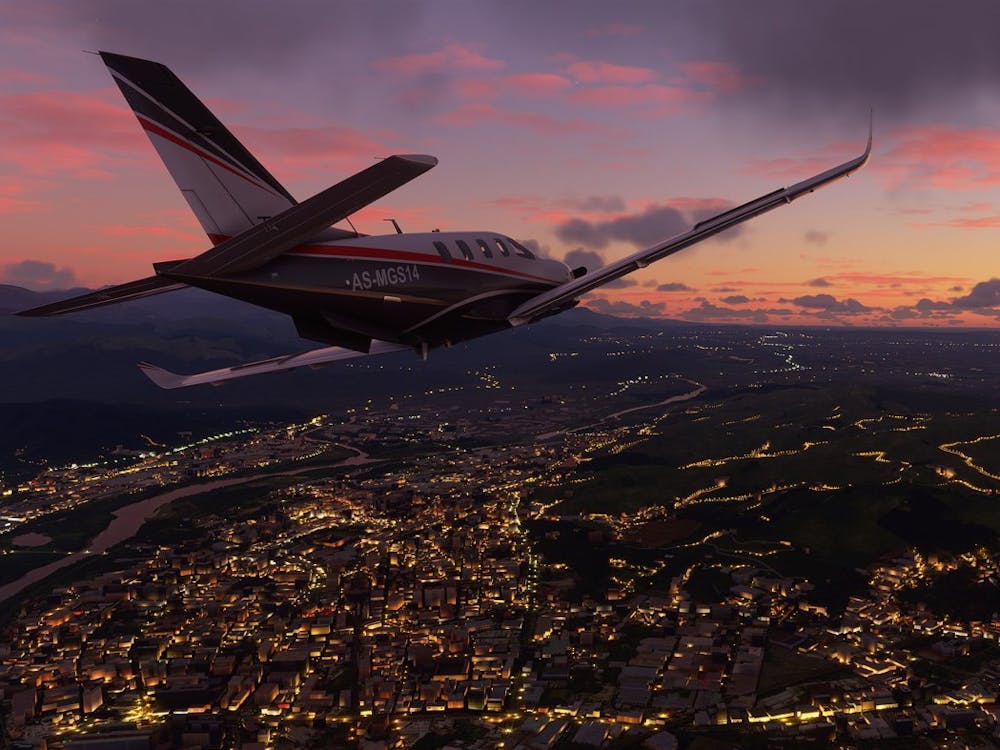Travel won’t be the same for a while, but the release of “Microsoft Flight Simulator” on Aug. 18 is a breathtaking leap for virtual realism that serves as more than just a game.
I wouldn’t say I adore airplanes, for many reasons. They’re noisy, metal contraptions that barrel through the air at speeds of more than 500 miles per hour, for one. My heart seems to drop to the pit of my stomach at the slight sign of rough turbulence, and there aren’t words to describe how I feel when an unruly passenger goes above and beyond to make a flight attendant’s job all the more difficult (see : this “Key & Peele” short).
But the shining light for me in an aircraft’s darkness has always been, maybe surprisingly, the window seat. Aside from its protection from the outward elbows of fellow passengers making their journey to the restroom (aisle seat lovers, my condolences) and the terrifying thought of being sandwiched between two complete strangers, the window seat has the added benefit of access to lift the window shade and gaze out at the tiny world below. Roads sprawl like intricate hand-drawn lines filled with indiscernible dots, and buildings look to have shrunk in a mere matter of minutes to the size of LEGO sets. It’s this kind of wonder and awe that “Microsoft Flight Simulator” not only replicates in unbelievable detail but also redefines by giving us the chance to virtually soar through the clouds as the pilot of our own planes.
“Microsoft Flight Simulator” is the latest installment in a long-running series of games — the first, “Microsoft Flight Simulator 1.0,” was released 38 years ago. This endurance is a testament to the game’s unwavering support from fans and aviation enthusiasts alike. The 2020 version far surpasses its predecessors by capturing beautiful cities and landscapes in unprecedented detail for a video game and allowing the player to travel anywhere on the planet. A flight to Los Angeles, Paris or Melbourne from any of the 37,000 real-life airports, or a custom point on the map, is more than possible through a groundbreaking recreation and digitalization of the entire planet, powered through Bing Maps’ satellite imagery and 3D photogrammetry data.
This game takes real-life simulation seriously by offering you full control of the aircraft, from departure to arrival, and real-life flight times based on measurements like wind speed and weather. For those wanting the full piloting experience, it may take a hefty amount of reading, tutorials and practice (with the occasional complete and utter failure) before you feel comfortable enough to lift off the runway without emergency sirens signaling your impending doom. However, if you’re in it for the opportunity to see the world’s wonders — and less so for learning the intricacies on how to fly a plane — there are plenty of assist controls that fast-track your pilot progress, taking pressure off the task of controlling a 45-ton vehicle through the sky.
By itself, this game pushes escapism to new yet familiar places, and virtually flying to anywhere in the world would sound amazing in any circumstance. The current circumstance we find ourselves in, however, transforms “Microsoft Flight Simulator” from an outstanding game to a wondrous and unique opportunity for healing.
We all had different plans in March. I was looking forward to spending the fall semester reconnecting with New York City in a completely different way through Duke’s study away program. I, along with many students across the nation, was gearing up for a summer or semester away from my home university. But the rapidity at which those plans changed was disorienting, and the idea of studying away from Duke was sadly redefined to studying at home for many of us. We haven’t had the time to make space for ourselves and deeply comprehend what our new reality might be.
This is where “Microsoft Flight Simulator” becomes truly special. I can set up my own virtual flight from Atlanta to New York, ditching my overweight luggage and overstuffed carryon for a more comfortable trip, and use the 2-hour flight to escape this reality while taking care of my own thoughts and feelings. The drone of the plane’s propellers accompanied with the beautiful scenery along the east coast feels therapeutic in a way I have yet to experience in other popular games.
Of course, we all would want our travels to physically transport us, but in our current situation, there’s something about taking off from Hartsfield-Jackson Airport in my own Aviat Pitts Special S2S, making a short detour to Durham to circle around the Duke Chapel and using my plane’s landing gear to touch down (albeit a bit roughly) in New York’s LaGuardia Airport that makes me want to put on an aviator hat and embark on this new way of adventure.
Get The Chronicle straight to your inbox
Signup for our weekly newsletter. Cancel at any time.

